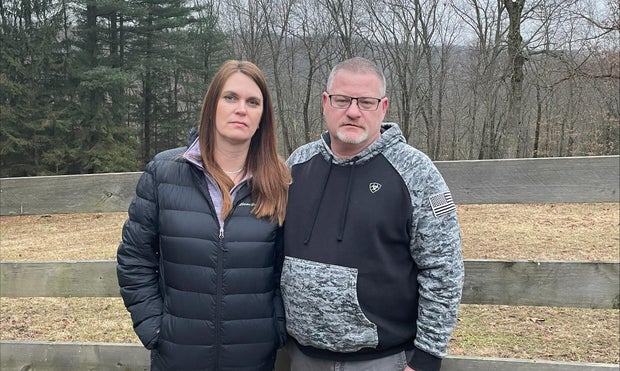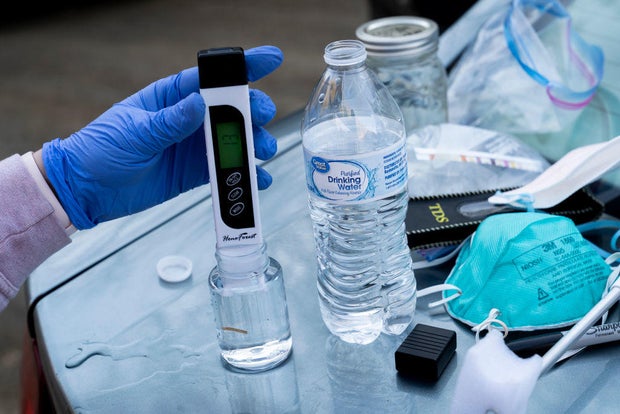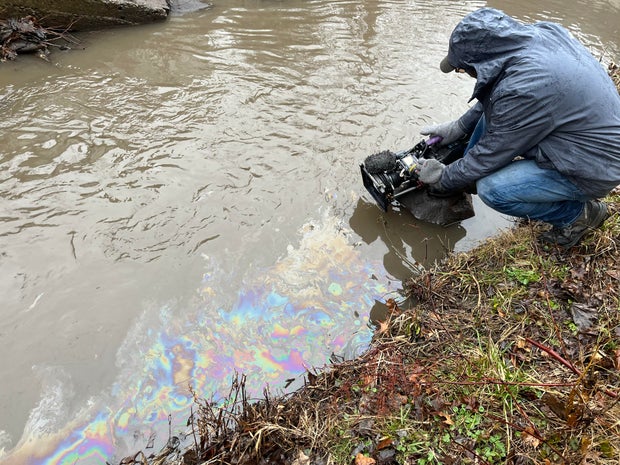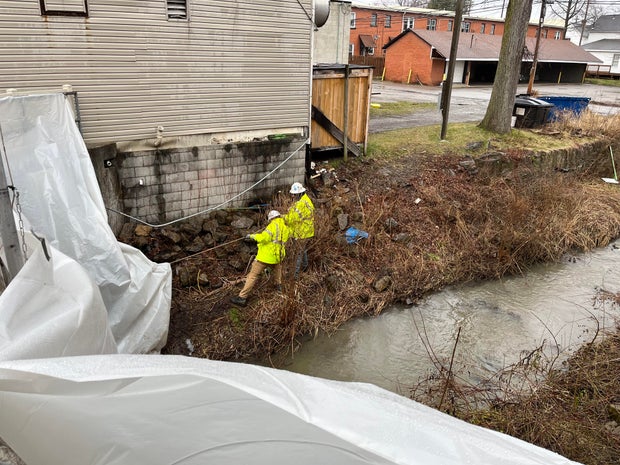East Palestine, Ohio, residents still suffering health issues a year after derailment: "We are all going to be statistics"
Watch the CBS Reports documentary "Toxic Fog: The Aftermath in East Palestine, Ohio" in the video player above.
One year after a freight train carrying hazardous materials derailed in East Palestine, Ohio, Linda and Russ Murphy, who live on a farm 2.8 miles away, say they are still suffering from strange health symptoms they never had before.
"My periods were completely normal up until the derailment," said Linda Murphy. "They stopped, just stopped."
Russ Murphy said he suffers from diarrhea daily, as well as from occasional dizziness, blurry vision and "cognitive issues."
Both suspect the derailment and the toxins released are behind their symptoms.
Three days after the derailment, officials decided to burn off five tank cars of vinyl chloride to avoid what rail operator Norfolk Southern warned could be a catastrophic explosion. Vinyl chloride is a highly combustible gas used to make plastic and other synthetic materials. It's also a known carcinogen.
What became known as the "vent and burn" unleashed a cloud of smoke that wafted east into Pennsylvania and beyond.
"They basically nuked your town," Russ Murphy said his doctor told him.
"There's carcinogens that have been released," Linda Murphy said. "It wasn't just magic pixie dust and it didn't go and just disappear into the air not to be seen or breathed again."
Both said they still sometimes smell a chemical odor they compared to "nail polish remover" or "airplane model glue" in their yard.
State and federal agencies have reassured residents that samples taken so far indicate the air in people's homes, the soil in their yards, and their drinking water are all safe. Much of the sampling data they use comes from firms contracted by Norfolk Southern, after the U.S. Environmental Protection Agency ordered the company to clean up the contamination.
Two firms that the rail operator brought in to test private wells were AECOM and, later, Stantec.
The Murphys said both sent a team to their farm and that neither reported dangerous levels of chemicals in their well water.
The EPA told CBS News that it closely supervises Norfolk Southern's contractors. The couple, however, does not believe the results. They stopped drinking their well water and now rely on bottled and filtered water. They still use their well water to shower and wash laundry.
When CBS News reached out to AECOM and Stantec for comment, they deferred to Norfolk Southern.
Norfolk Southern insists East Palestine is safe
Norfolk Southern says it has committed more than $100 million to helping the community since the derailment, including protecting the drinking water, supporting businesses and schools, and upgrading a park.
"I want to say to the residents that it is safe in East Palestine," Will Harden, a senior director of legal claims at Norfolk Southern, told CBS News.
When asked whether the company would help the community pay for long-term health care and monitoring if needed, particularly if — as some residents worry — there is ever a cancer cluster in the future, he said, "From a long-term health standpoint, we are addressing that with the state and local authorities, and that's continuing to be discussed," adding, "It is an option that is on the table."
The EPA says that, as of Jan. 25, more than 176,000 tons of solid waste and more than 47 million gallons of wastewater have been removed from the derailment area, and that the agency plans to continue to help monitor groundwater for years to come.
The sediment from two local waterways, Leslie Run and Sulphur Run, is "being evaluated and compared to human health and ecological risk threshold criteria," the EPA says.
East Palestine residents express concern: "I just want honesty"
CBS News spoke with many residents who said the derailment and its aftermath have divided the community between those who want to move on and those who think it's too soon.
Several said they were not experiencing any symptoms and that they wanted to — as one business owner put it — get "the word out that we feel like it's safe for people to come here."
But others feel it's irresponsible to welcome outsiders to the area.
Joe Sheely, a pastor who lives a mile and a half from the derailment site, said after the derailment and the vent and burn, he began to suffer from skin lesions, brain fog and memory loss. He also said a CT scan found a "nodule" on his left lung.
Norfolk Southern contractor Stantec tested his drinking water and told him "it appears to be good," he said, but he wants more confirmation that the home, where he and his wife looked forward to spending their retirement, is safe.
"I'm not trying to throw Norfolk Southern under the bus," Sheely said. "I just want honesty. Are they incapable of actually measuring the levels of contamination on the property? People's lives are at stake — not just ours but everyone in town."
Survey finds many residents experiencing symptoms
Jonathan Kent, who lives on a farm one mile east of the derailment site, just across the border in Pennsylvania, said he began to have seizures soon after he returned home after the vent and burn. One day, he said, he fell next to his bed, where his wife found him "convulsing and foaming at the mouth." He said he has been diagnosed with epilepsy and can no longer drive or continue his physical work as an arborist.
Kent is part of a class-action lawsuit filed by thousands of residents in Ohio, Pennsylvania and West Virginia against Norfolk Southern and Oxy Vinyls, the producer of the vinyl chloride that was on the derailed train. Nicholas Amato, one of the attorneys representing the plaintiffs, alleged to CBS News that hundreds of them are still reporting symptoms they did not have before the derailment.
Dr. Erin Haynes, chair of the University of Kentucky's department of epidemiology and environmental health, surveyed around 400 adults in the East Palestine area last fall. She found that 3 out of 4 residents said they had experienced new health symptoms after the derailment and that over half said their symptoms continued into the fall. Symptoms that were reported included nose and eye irritation, coughing and wheezing, nausea, vomiting, diarrhea, rashes and feeling weak and tired.
"There is no question there was an exposure for the vast population," Haynes said, adding that members of the community should have been monitored from the start, with urine and blood samples collected early. They will also need long-term health care monitoring by staff trained in environmental health and exposures, she said.
The East Palestine disaster is just one of the latest in the United States to expose "the major gaps in our public health response," Haynes said. "East Palestine isn't alone in experiencing environmental disasters related to chemical spills or releases, which occur all across the U.S., but this disaster really demonstrates the lack of a public health response for community residents."
Another problem in East Palestine is that the EPA is using an "antiquated analysis" to decide if the community is facing any health risks, according to Stephen Lester, a toxicologist and the science director of the Center for Health, Environment & Justice, an environmental activist group.
"They rely on research that looks at exposure to one chemical at a time, but people were exposed to 10 to 12 chemicals," Lester estimated. "As a scientific community, there isn't an understanding of low-level mixtures of chemicals and what that means to people exposed," especially over months or years.
Dr. Beatrice Golomb, a professor of medicine at the University of California, San Diego, who is tracking many residents' symptoms, agreed.
"Even if we knew what all the chemicals were that were released and produced with the vent and burn, for a number of them we don't have good quality data to say what levels are problematic," she said. "You can't do experimental human studies to look for safety because that would be considered unethical."
She added, "Even if it could be known if levels of individual chemicals are safe, in combination, chemicals can produce vastly greater toxicity."
EPA says researchers "routinely looking at chemicals"
Mark Durno, an emergency response supervisor with the EPA, told CBS News that while his agency had not seen levels of chemicals that exceed its "risk thresholds," he "can't deny some of the reactions that some of the community members had, coming back into town."
He said some people may be reacting to early exposure, "something triggering from the derailment incident," or stress. Durno added that his agency has a "staff full of researchers and toxicologists that are routinely looking at chemicals" and chemical exposures.
He acknowledged, however, that it's possible that not enough is known about the potential effects of chemicals like vinyl chloride or butyl acrylate on human beings.
"That's part of what the research hopefully can start to tease out," he said.
"We're all going to be statistics"
In December, the EPA announced it would begin a formal review of vinyl chloride to determine whether it poses an "unreasonable risk to health or the environment." The process, which could take at least 3 years, could eventually lead to more restrictions on the chemical or even a ban.
The Murphys now keep large binders filled with research on chemicals, most of which they had never heard of before the derailment — not only vinyl chloride but also others that burned, leaked or were otherwise released in the disaster.
"I'm convinced that people in this town were breathing in stuff and were subjected to it in one form or fashion for a period of time, and are we still, and how?" Linda Murphy said. "Will we ever be told the truth?"
She added: "I think we're all going to be statistics, and that's fine if it helps somebody else out. But what a shame. What a shame to be part of this research we didn't sign up for."
–Nathalie Nieves and Sarah Metz contributed reporting.









